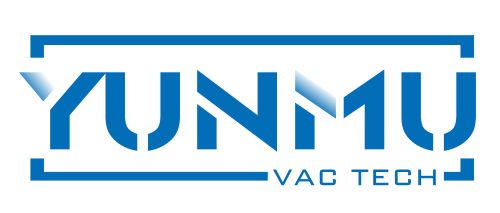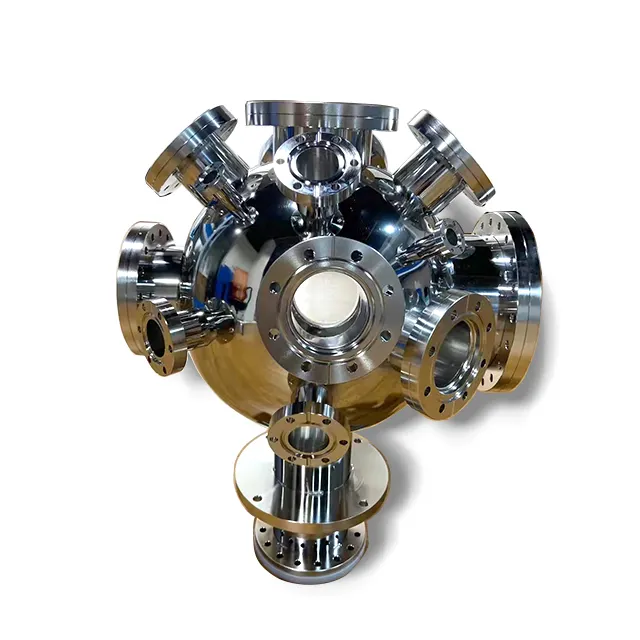진공 시스템에서 게이트 밸브의 핵심 역할 이해하기
고진공 응용 분야의 정교한 세계에서 진공 게이트 밸브는 시스템의 최적 성능과 신뢰성을 보장하는 데 없어서는 안 될 구성 요소입니다. 이러한 특수 밸브는 진공 상태의 무결성을 지키는 역할을 하며, 다양한 산업 및 과학 공정에 필수적인 가스 흐름 제어와 정밀한 압력 조건 유지에 기여합니다. 반도체 제조부터 입자 가속기까지, 고품질 진공 게이트 밸브의 적용 여부는 핵심 작업에서 성공과 실패를 가르는 요소가 될 수 있습니다.
핵심 구성 요소 및 설계 특징
고급 밀봉 메커니즘
진공 게이트 밸브의 핵심은 정교한 밀봉 시스템에 있습니다. 최신 설계는 공기 유입을 완전히 차단하는 엘라스토머 또는 금속 밀봉재를 채택하고 있습니다. 이러한 밀봉재들은 극한의 압력 차에도 그 무결성을 유지하도록 설계되었으며, 종종 Viton(비톤)이나 금속 결합 화합물과 같은 특수 소재를 사용하여 열화에 저항하면서 수천 사이클 동안 일관된 성능을 보장합니다.
씰링 장치는 일반적으로 2단계 설계를 채택하며, 주 씰이 압력 차의 대부분을 처리하고 보조 씰이 누출 방지를 위한 이중성과 추가 보호 기능을 제공합니다. 이러한 이중 씰 구조는 초고진공(UHV) 조건을 요구하는 응용 분야에서 산업 표준으로 자리 잡았습니다.
정밀 구동 시스템
진공 게이트 밸브의 구동 시스템은 공학적 정밀도의 걸작입니다. 공압식, 수동식 또는 전자 제어 방식에 관계없이 이러한 시스템은 씰의 무결성을 유지하면서 원활하게 작동해야 합니다. 고급 구동 장치에는 실시간 상태 업데이트를 제공하고 밸브 작동에 대한 정밀한 제어를 보장하는 위치 피드백 장치가 포함되어 있습니다.
최신 설계는 전원 손실 또는 시스템 고장 시 밸브를 자동으로 닫는 페일세이프(fail-safe) 메커니즘을 포함하는 경우가 많아 민감한 장비를 보호하고 진공 상태를 유지할 수 있습니다. 스마트 제어 기술의 통합을 통해 원격 조작 및 모니터링이 가능해 자동화된 제조 환경에서 필수적인 요소가 됩니다.
성능 특성 및 응용 분야
진공 등급 및 누출 밀폐성
고성능 진공 게이트 밸브는 뛰어난 밀봉 성능을 유지하도록 설계되었으며, 일반적으로 1x10-9 mbar-l/s 이하의 매우 낮은 누설률을 달성합니다. 이러한 뛰어난 밀봉 능력은 미세한 오염만으로도 제품 품질이 저하될 수 있는 박막 증착과 같은 응용 분야에서 특히 중요합니다. 이러한 밸브의 진공 등급은 종종 초고진공(UHV) 영역까지 확장되며, 가장 까다로운 과학적 및 산업용 응용 분야에 적합합니다.
엔지니어는 진공 게이트 밸브를 선택할 때 전도율, 사이클 수명, 재료 호환성과 같은 요소들을 고려해야 합니다. 밸브가 다양한 공정 가스와 온도 조건에서 반복 작동 시에도 일관된 성능을 유지하는 능력은 시스템의 신뢰성과 정비 요구 사항에 직접적인 영향을 미칩니다.
산업별 요구사항
다양한 산업 분야에서는 진공 게이트 밸브에 특정 기능이 요구됩니다. 반도체 제조의 경우 청정성과 입자 발생이 가장 중요한 문제입니다. 이러한 응용 분야에서는 탈기 및 입자 발생을 최소화하는 재료로 제작된 밸브가 필요하며, 특수한 표면 처리와 세척 절차를 포함하는 경우가 많습니다.
입자 가속기나 질량분석기를 운영하는 연구 시설의 경우, 급격한 압력 변화를 견디면서도 극한의 진공 상태를 유지할 수 있는 진공 게이트 밸브가 필요합니다. 진공 시스템의 특정 구간을 신속하고 신뢰성 있게 차단하는 능력은 운영 효율성과 장비 보호 모두에 필수적입니다.
설치 및 유지 관리 고려 사항
올바른 설치 절차
진공 게이트 밸브의 성능은 적절한 설치 절차에 크게 의존합니다. 정렬, 장착 방향 및 연결 부위의 완전성을 주의 깊게 점검해야 하며, 설치자는 마운팅 부품에 대해 정확한 토크 사양을 따라야 하고, 최상의 성능을 보장하기 위해 개스킷 표면을 적절히 준비해야 합니다.
설치 계획 수립 시 진동, 온도 변화, 공간 제약과 같은 환경적 요인들을 고려해야 합니다. 적절한 지지 구조 및 진동 격리 장치를 적용하면 밸브 수명을 크게 연장하고 밀봉 성능을 유지할 수 있습니다.
예방적 유지 보수 전략
진공 게이트 밸브의 장기적인 신뢰성을 보장하기 위해서는 포괄적인 정비 프로그램이 필수적입니다. 밀봉면, 액추에이터 부품, 제어 시스템에 대한 정기 점검을 통해 시스템 고장으로 이어지기 전에 잠재적 문제를 조기에 발견할 수 있습니다. 정비 주기는 운전 조건, 작동 빈도 및 제조사 권장 사항을 기준으로 설정되어야 합니다.
주기적 점검 및 성능 측정을 포함한 유지보수 활동의 문서화는 서비스 요구 사항 예측과 시스템 운영 최적화를 위한 귀중한 데이터를 제공합니다. 밸브 작동 시간 및 씰 성능 모니터링과 같은 예지 정비 기술을 적용하면 예기치 못한 가동 중단을 방지할 수 있습니다.
미래의 동향과 혁신
스마트 밸브 기술
스마트 기술의 통합은 진공 게이트 밸브 설계에 혁신을 가져오고 있습니다. 고급 센서와 통신 기능을 통해 밸브 위치, 씰 무결성 및 운전 조건을 실시간으로 모니터링할 수 있습니다. 이러한 데이터를 분석하여 시스템 성능을 최적화하고 유지보수 필요 시점을 예측함으로써 가동 중단 시간과 운영 비용을 줄일 수 있습니다.
제조업체들은 밸브 성능의 미세한 변화를 감지할 수 있는 자체 진단 기능을 개발하고 있으며, 고장 발생 전에 예방적 유지보수가 가능하게 해줍니다. 산업용 사물인터넷(IIoT) 연결성의 도입은 원격 모니터링 및 제어를 가능하게 하며, 현대 제조 환경에서 필수적인 요소가 되고 있습니다.
재료 과학의 발전
재료 과학 분야의 지속적인 연구는 씰 재질과 밸브 구조의 개선을 계속해서 이끌어내고 있습니다. 새로운 복합재와 표면 처리 기술은 내구성 향상, 마찰 감소 및 화학 저항성 개선을 제공합니다. 이러한 발전으로 인해 진공 게이트 밸브는 점점 더 까다로운 응용 분야에서도 신뢰성 있는 성능을 유지하며 작동할 수 있게 되었습니다.
새로운 코팅 기술의 개발은 부식 및 마모에 대해 더 나은 보호를 제공하여 밸브 수명을 연장시키고 유지보수 요구사항을 줄입니다. 이러한 혁신은 공격적인 공정 가스 또는 극한의 온도 조건을 포함하는 응용 분야에서 특히 유용합니다.
자주 묻는 질문
진공 게이트 밸브는 얼마나 자주 정비해야 하나요?
진공 게이트 밸브의 정비 주기는 운전 조건, 사이클 빈도 및 환경과 같은 여러 요소에 따라 달라집니다. 일반적으로 연간 단위로 종합 점검을 수행하고, 사용 빈도와 제조업체 권장 사항에 따라 개스킷 표면과 액추에이터 기능을 보다 자주 점검해야 합니다.
진공 게이트 밸브 고장의 원인은 무엇인가요?
일반적인 고장 원인으로는 씰의 열화, 씰 표면의 오염, 액추에이터 부품의 기계적 마모, 부적절한 설치 또는 유지보수가 있습니다. 과도한 진동이나 온도 변화와 같은 환경적 요인은 마모를 가속화하여 조기 고장을 유발할 수 있습니다.
진공 게이트 밸브를 현장에서 수리할 수 있나요?
일부 정비 작업은 현장에서 수행할 수 있지만, 주로 큰 수리는 밸브를 제거하고 청결한 환경에서 서비스를 받아야 합니다. 적절한 성능을 보장하고 보증 범위를 유지하기 위해 씰과 같은 중요 부품은 제조사 승인 부품과 절차에 따라 교체해야 합니다.

